The theme of the Annual Conference of the Irish Labour History Society this year is – ONE HUNDRED YEARS OF THE LABOUR PARTY
Venue: ILHS centre, Beggars Bush, Haddington Road, Dublin 4.
Friday
7.30pm: Emmet O’Connor, ‘The Century of the Party: Much to acclaim or labour in vain?
Saturday
10.00am: Address by Eamon Gilmore, Labour Party leader and Tanaiste
Session 1 – 10.30am to 11.45am:
Session Chair: Theresa Moriarty
10.30am: Sean O’Donnell, The Labour Movement and the Clonmel Connection
11.00am: Brendan Byrne, Labour Must Wait
11.15: Brendan Halligan, Building Democracr: The Johnson Years
Session 2 – 11.45 to 1.00pm
Session Chair: Caitriona Crowe
11.45am: John Cunningham, ‘As much right to be termed a Labour man as a Transport worker’: The public career of T J O’Connell
12.05: Kevin Murphy, ‘The people as a whole are much more concerned about their own constitutions’: Labour’s opposition to the 1937 Draft Constitution
12.30 to 1.00pm: Questions and Answers
Lunch Break 1pm to 2pm : Sanwiches, tea and coffee provided
Session 3 – 2.00 to 3.00pm
Session Chair Jimmy Somers
2.00pm: Barry Desmond, The Norton Legacy
2.30pm: Niall Greene, Brendan Corish – ‘The man for Ireland’
Session 4 – 3.30 to 5.00pm
Session Chair Francis Devine
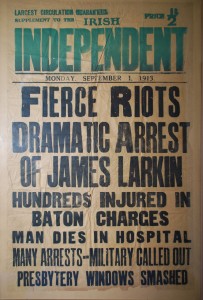
Irish Independent headline for Bloody Sunday
Panel of Experience: Frank and Ger Lewis, Rayner Lysaght, Seamus Scally, Pat Magner, Jane Dillon Byrne and Eithne Fitzgerald
5.00pm: Closing summation by Francis Devine
Padraig Yeates on October 6, 2012 | Filed Under Uncategorized | Comments Off on Annual Conference of Irish Labour History Society – Friday, October 12th and Saturday, October 13th
The Working Class Movement Library, famous for its Irish collection, plays host on Saturday 13 October to a talk on ‘Ireland’s forgotten revolutionary’.
Even for those who consider themselves reasonably well-versed in the history of the Irish rising of 1916 and of the tumultuous events of the years which followed, there’s every possibility that the name of at least one major participant, Sean McLoughlin, will not be overly familiar. In most major studies of the period McLoughlin, whose conduct during the the events of Easter Week 1916 saw him promoted in the dying hours of the Rising to the position of commandant-general of the forces of the Irish Republic, has until recently merited little more than a passing reference and the odd footnote, if mentioned at all.
Charlie McGuire’s book Sean McLoughlin, Ireland’s Forgotten Revolutionary charts the remarkable story of a man who progressed from republican to socialist and communist politics and who not only played a major part in Ireland’s fight for freedom over several years but who also contributed to the struggle for revolutionary socialism in Britain in the early-mid 1920s.
We’re delighted to have Charlie come to speak at the Library on Saturday 13 October at 2pm. All welcome; admission free; light refreshments.
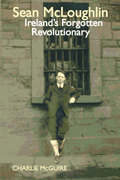
- The Library collection contains books, pamphlets, personal archives, photographs, plays, poetry, songs, banners, posters, badges, cartoons, journals, biographies, newspaper reports and more. They tell the story of Britain’s working classes from the earliest days of industrialisation to the present day.
- The Library is open to the public on Wednesday, Thursday and Friday afternoons. At other times visitors are welcome to make appointments to view or use the collection. Admission to the library is free.
- Further details of all the autumn events at the Library at www.wcml.org.uk/events
Padraig Yeates on October 4, 2012 | Filed Under Uncategorized | Comments Off on Ireland’s forgotten revolutionary remembered in Salford
Dublin Council of Trade Union is proposing a re-enactment of Bloody Sunday on September 1st, 2013. Hopefully we have full universal health insurance by then. Meanwhile here is a link to a clip from RTE on the 90th anniversary with Jer O’Leary as Jim Larkin. Thanks to Jim Curry, author of ‘Artist of the Revolution: The Cartoons of Ernest Kavanagh (1884-1916)’ for finding it
http://www.euscreen.eu/play.jsp?id=EUS_7B43A12E3F514BD3AA5436DF6D0640FE
Live footage of the original Lockout is extremely scarce so anyone out there who knows where it can be located please let us know
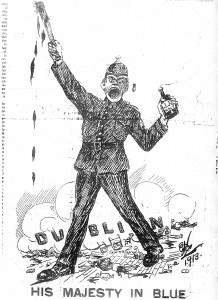
His Majesty in Blue – Irish Worker, September 13th, 1913
Padraig Yeates on September 25, 2012 | Filed Under Uncategorized | Comments Off on Re-enacting Bloody Sunday
Matthew Connolly was the younger brother of Sean Connolly, the Irish Citizen Army officer who was among the earliest rebel casualties on Easter Monday. His Witness Statement is interesting because it shows the ICA had a youth group and suggests at least one other ICA member was killed before his brother at City Hall. It is interesting on Dr Kathleen Lynn and records the amazing fact that Matthew’s father, four brothers and a sister were all ICA members
http://www.bureauofmilitaryhistory.ie/reels/bmh/BMH.WS1746.pdf
Padraig Yeates on September 23, 2012 | Filed Under Uncategorized | Comments Off on Boy soldier of Citizen Army
A fresh start for Clery’s on its historic site in Dublin’s O’Connell Street is very welcome, not to mention saving around 350 jobs. The site has hosted a department store since 1853. Jim Larkin made a brief appearance at the window below the clock to make the briefest speech of his career.
The police reaction below led to Dublin’s first of four Bloody Sundays in the twentieth century. Anyone who wants to know a bit more about the most (in)famous event associated with the building should visit http://storymap.ie/ and click on ‘The first Bloody Sunday’ balloon in O’Connell Street.
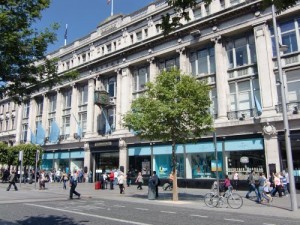
Batons under the Clock
Padraig Yeates on September 18, 2012 | Filed Under Uncategorized | Comments Off on The first of Dublin’s four Bloody Sundays
Frank Robbins joined the Irish Transport and General Workers Union when he was 15 and was a life long member of that Union and the Irish Labour Party. He joined the Irish Citizen Army in 1914. His Witness Statement gives an insider’s view of the labour movement in the lead up to the Easter Rising. It is as interesting for the insights it gives into the mindset of a young revolutionary activist, who combined socialist beliefs with a strong sense of Irish nationality and commitment to his Catholic faith, as for the historical details.
Robbins is highly critical of Jim Larkin and had a much higher regard for Connolly, although he argues that one reason for the failure of the ICA to expand was the latter’s unpopularity in Dublin.
This Witness Statement clearly forms the basis for Robbins’s book ‘Under The Starry Plough’, long out of print. The discrepancies between the two are also interesting.
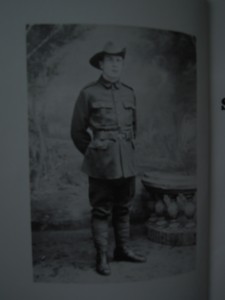
Frank Robbins in Citizen Army uniform
http://www.bureauofmilitaryhistory.ie/reels/bmh/BMH.WS0585.pdf
Padraig Yeates on September 17, 2012 | Filed Under Uncategorized | Comments Off on An ICA Sergeant’s Story
The 1913 Alternative Visions Oral History Training Course got off to a great start on Saturday (September 15th), with the 20 participants engaging in a lively session at the TEEU training rooms in Gardiner Place. Course leaders Mary Muldowney and Ida Milne are delighted with the energetic response.
If anyone is interested in taking part in another oral history training course run along the same lines, please email 1913alternativevisions@gmail.com with your name and telephone number, your union membership details, the reason for your interest (interest in history and/or a family/community/work related experience of the Lockout). We’re already building a waiting list for the next course, in the hope that we will get funding.
Padraig Yeates on September 16, 2012 | Filed Under Uncategorized | Comments Off on First 1913 Oral History Course starts in Dublin
John Hanratty was an oven hand at Jacob’s biscuit factory and on the local union branch committee. He was an officer in the Irish Citizen Army and became Commandant during the Civil War. This brief Witness Statement conveys something of the atmosphere in the early days of the union, the Lockout and formation of the ICA.
Unfortunately, the narrow remit of the Bureau of Military History means that most of the space is taken up with the minutiae of the Easter Rising.
One intriguing figure who appears in Hanratty’s recollections and in many other Witness Statements is Robert de Coeur, ICA officer, union activist and founder of the Fintan Lawlor Pipe Band. Unfortunately he died before he could give his testament to the Bureau, or anyone else.
http://www.bureauofmilitaryhistory.ie/reels/bmh/BMH.WS0096.pdf
Padraig Yeates on September 14, 2012 | Filed Under Uncategorized | Comments Off on ICA officer recalls Lockout
Our thanks to Tom Duke for pointing out the following links below to the Labour Party’s Centenary picture archives. They are well worth a visit.
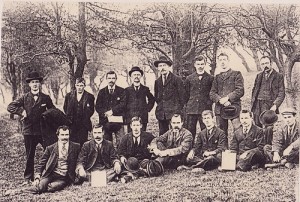
Irish Socialist Republican Group in Phoenix Park, May 1901. Seated, Left to right: John Arnall, E W Stewart, Thomas Brady, James Connolly, John J Lyng, William O’Brien, and John Carolan. Standing, left to right: W J Bradshaw, John Brannigan, J Goff, Mark Deering, Murtha J Lyng, Daniel O’Brien, Thomas J Lyng and James Bishop.
http://www.labour.ie/centenary
http://www.labour.ie/centenary/timelinefullscreen/
http://www.flickr.com/photos/labourparty/sets/72157629408133039/
http://www.flickr.com/photos/labourparty/6876152854/in/set-72157629408133039
http://www.flickr.com/photos/labourparty/7022287297/in/set-72157629408133039
Padraig Yeates on September 12, 2012 | Filed Under Uncategorized | Comments Off on Labour Party Centenary – Some Pictorial History
Henry Banks was a storeman with Dublin Corporation. This short Witness Statement is probably indicative of the attitude of many Dublin Volunteers. They did not like Larkin or ‘internationalism’ but were more accommodating of hostility from within the nationalist establishment, including the Catholic Church.
Banks’s job security probably reinforced his natural conservatism on most issues – he really only parted company with the Redmondites on recourse to violence to achieve nationalist goals. It would be interesting to know whether he was politically active post 1922 and, if so, with whom? Anyone out there have any further information about him?
http://www.bureauofmilitaryhistory.ie/reels/bmh/BMH.WS1637.pdf 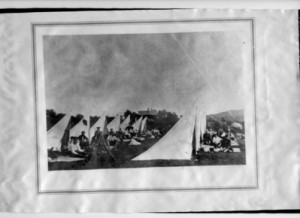 Amateur solidiers and camping enthusiasts – This photograph is of an Irish Volunteers’ camp in 1915, in the Galtee Mountains. It is from Bureau of Military History Collection
Amateur solidiers and camping enthusiasts – This photograph is of an Irish Volunteers’ camp in 1915, in the Galtee Mountains. It is from Bureau of Military History Collection
Padraig Yeates on September 11, 2012 | Filed Under Uncategorized | Comments Off on Henry Banks – View from Dublin Volunteer mainstream







 Amateur solidiers and camping enthusiasts – This photograph is of an Irish Volunteers’ camp in 1915, in the Galtee Mountains. It is from Bureau of Military History Collection
Amateur solidiers and camping enthusiasts – This photograph is of an Irish Volunteers’ camp in 1915, in the Galtee Mountains. It is from Bureau of Military History Collection